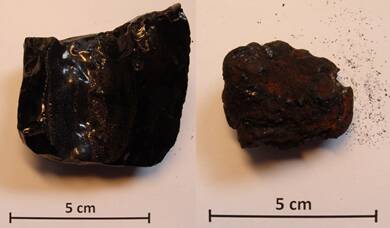
Investigation of the ractivity of furfural for an improved biorefiniery process
Furfural is gained as side-product from the pulping process and causes insouluble depositions in the plant. wood k plus investigated influencing factors in order to be able to aviod them in the future.
The biorefinery plants of Lenzing AG produce pulp and various cellulose fibers such as viscose, lyocell or modal. From the waste liquor of the dissolving pulp process, other chemicals with high purity are produced and marketed as by-products, e.g. acetic acid and furfural.
After separation of the raw pulp, the cooking liquor is evaporated, whereby acetic acid and furfural accumulate in the so-called Brüden condensate. In the subsequent biorefinery plant, these chemicals are extracted, separated and purified in a multi-stage process. During the extraction with organic solvents as well as in the following cleaning steps insoluble, black, sticky to brittle deposits are formed. On the one hand, this reduces the yield and, in addition, the operation of the plant must be repeatedly interrupted for cleaning work. Until now, it was unclear what causes these deposits, but it was suspected that there is a connection with the reaction of furfural to larger polymers.
In the diploma thesis of Lukas Almhofer, embedded in the project Lenz 1.6, different conditions in the laboratory were simulated to find out the influencing factors for the formation of those deposits. Parameters such as temperature, time, and concentration of furfural, water content and solvent composition were investigated. Furthermore, it was clarified whether oxygen exclusion or the use of different stabilizers can prevent the formation of the deposits.
Evaluation of the influencing parameters
Laboratory tests in small steel reactors showed that the concentration of furfural in aqueous solutions decreased up to 40% within a few hours, forming a black deposit, whereas in various organic solvents only low decomposition rates and a slight yellowing of the solutions were observed. Besides the presence of water, temperature, concentration and reaction time were identified as important influencing factors. An impact of the acetic acid concentration or the pH value was not confirmed.
In order to be able to draw conclusions about the reaction mechanisms, the reaction products of the laboratory tests were examined. An anion chromatography showed the formation of formic acid. This observation, in conjunction with the results of the infrared spectroscopic investigations, indicates a reaction between furfural and water molecules, which produces reactive dialdehydes. These react with each other and subsequently lead to the formation of the black solids. The application of various separation methods with subsequent mass spectrometry has shown that other reactions, such as oxidation, also occur in parallel. The use of different inhibitors was unable to prevent the formation of the deposits. However, laboratory tests under inert gas atmosphere have shown that the exclusion of oxygen can partially prevent the degradation of furfural.
The comparison of the samples from the laboratory tests with process samples showed that the biorefinery also contains a large number of other substances that originate from the biomass used. These include fatty acids and degradation products of sugar and lignin molecules. Whether and to what extent these accompanying substances influence the formation of deposits will be clarified in further investigations.





